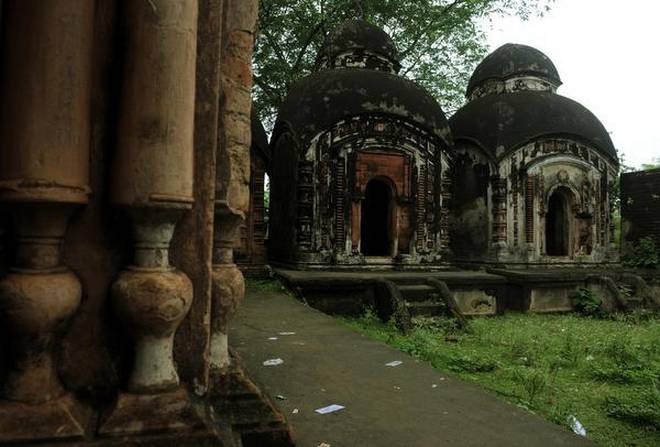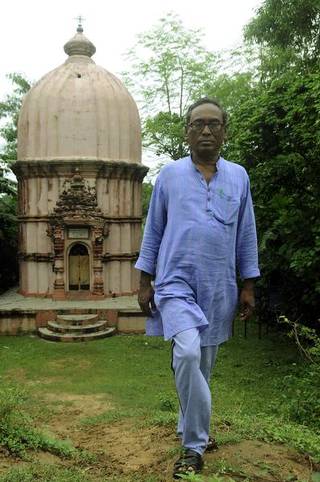Pathra, Midnapore District, WEST BENGAL :

Today, 19 of the 34 temples in Pathra in West Bengal have been restored to their former glory
“Bash on.” That’s probably what Yeasin Pathan says to himself when he wakes up every morning. You just can’t miss his never-say-die attitude when you meet the frail 66-year-old. How else do you explain the grit of a Class IX dropout, and a devout Muslim, who has been crusading for the conservation of 34 temples for the last 42 years?
Pathan has been in love with Hindu temples ever since he was a child. Looked upon with suspicion by both Hindus and Muslims for this long love affair, Pathan is today inured to the jibes, threats and hurdles.
The story begins when Pathan was a child. Captivated by the terracotta temples he chanced upon in Pathra, a village close to his own, in Midnapore district of West Bengal, their dilapidated condition set him thinking. And by the time he was 17, he had kick-started his ‘save the temples’ mission. This was in 1971. He had no archaeology or history degree to show on his CV, but Pathan realised the temples were “part of our heritage, and people should be prevented from walking away with bits of it.”
Garnering support
To start with, Pathan got the villagers together, Hindus, Muslims and Adivasis. He told the people of Pathra it was in their hands to preserve their heritage for posterity. As expected, Pathan found himself up against opposition. People from his community were enraged he was advocating the preservation of structures where idols are worshipped. “The Hindus of the area were miffed too, because I prevented them from stealing the bricks off the temples and selling them,” he says, smiling.
Statues for sale
Even the descendants of the zamindars who had built the structures were trying to make money by selling carvings and statues. Pathan was, clearly, surrounded by a ring of fire. That’s when innate wisdom told him he must give the locals a vision to aspire for: that if Pathra became a tourist destination, “the village and its adjoining areas would get roads, electricity, water, and business.” The semblance of a truce followed.
Under his leadership the local community set about first clearing the wild growth of weeds around the monuments. Then, Pathan mobilised rallies at the district headquarters in Midnapore to demand funds. There were scuffles, and he would rush to Midnapore to bring the police to Pathra.

But his efforts began to bear fruit.
Money started trickling in; IIT Kharagpur stepped in to help with the conservation. Pathan set up an NGO, Pathra Archaeological Preservation Committee, which, apart from its core agenda, also became a forum for communal harmony. The then Planning Commission Deputy Chairperson, Pranab Mukherjee, sanctioned ₹20 lakh for Pathra. The biggest victory for Pathan was when the Archaeological Survey of India (ASI) took over restoration work in 2003.
Guide for tourists
Meanwhile, Pathan realised he needed a steady source of income. He now had a wife and four children. To make ends meet, in 1974 he became an attendant in a school in Hatiholka, his village. He also worked as a stringer for newspapers, and when curious tourists visited Pathra, Pathan became their guide. But he never wavered in his mission to conserve the temples.
Although Pathra’s residents acknowledged his pioneering work over the years, he has faced testing times. Gasping for breath ( he has two blockages in his heart), he recounts how he had to go into hiding after the Babri Masjid demolition in 1992. “Muslims wanted to lynch me for protecting temples while Hindus were breaking mosques.”
Only one guard
Today, 19 of the 34 temples in Pathra have been restored to their former glory. All under the eagle eye of Pathan, who says ruefully: “Such a big area, and only one guard to protect it.” Some 9.5 acres around the temples are being beautified by ASI. Pathan’s new fight is to get 70 farmers their compensation for the land they had to give up around the temple.
“You know how it is… unless we make a noise, the state will take its own sweet time,” he says.
Dressed in a cotton shirt, trousers and chappals, the bespectacled Pathan retired from his school job in 2012, and gets a pension of ₹9,600 per month. His family wants him to take it easy now. The years of travel, the erratic sleep and irregular meals, have all taken a toll on his health. He can’t afford treatment for his heart and kidneys.
“Stay at home; rest, they say. But if I stop now, all those years of fighting will go down the drain. Now is when everything should fall into place,” says a tired but eternally optimistic Pathan.
Professional procrastinator and looker out of window, the writer works at O.P. Jindal University.
source: http://www.thehindu.com / The Hindu / Home> Society> Rubric / by Priya Kannungo / October 27th, 2018








